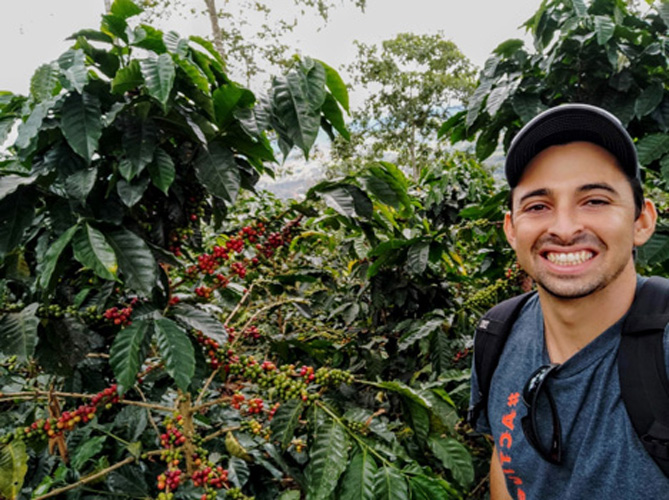Digital agriculture for smallholder farmers and adventures in Colombia

In most of my professional career, I have been focused on improving crop production by understanding the impacts of spatial and temporal variability at the field level. Taking these variations into consideration, instead of using just the averages, is the basis of precision agriculture. Most of the tools developed to implement the recommendations resulting from this strategy of crop management are focused on larger producers. There is still low adoption by smallholder farmers. I am very happy for being chosen to receive the Global Food Security Graduate Fellowship Program, because this opportunity gives me the chance to help fill this gap. The adoption of site-specific technology and digital tools by smallholder farmers has great potential for improving food security and production sustainability.
I am a Brazilian agronomist, coming from a family that has been farming for many generations. After finishing my master’s at the University of Sao Paulo I returned to Mato Grosso to be responsible for precision agriculture and technology adoption in a 400,000 acres agricultural complex. At this scale, everything is unique. Moving to Champaign I realized that although the scale and the weather are quite different, there are many similarities in the production systems of both countries. The adoption of modern varieties and hybrids, the mechanization, the high level of technology adoption and the high yields, just to list a few. Now that I start to better understand the production system in most of Mexico, Central America, and Colombia I see that there are also many differences. In this first stage of my project in partnership with the international center for tropical agriculture (CIAT) and the International Maize and Wheat Improvement Center (CIMMYT) we are working to improve maize production in the state of Chiapas, Mexico. The county-level average yields vary from less than 2 tons/ha to about 5 tons/ha; in comparison, in Illinois the averages are usually between 10 and 12 tons/ha.
Although the yields are lower, the production system is usually more complex than what is observed in the Midwest. There are many specific uses for the grain that can only be met by some varieties. There is maize intercropped with beans, pumpkins, cassava, and even trees. Choosing the best variety and adopting the best management practices in this complex production systems is very challenging. Extrapolating the results from a few research stations to every farmer is both difficult and risky, since each unique field may respond different. With so many unique field conditions the best way to improve crop production is to provide personalized recommendations, respecting the reality of each farmer. That’s why digital tools can have a great impact. By gathering a lot of information about each individual field for many years and leveraging the power of machine learning methods and weather forecasts, we can predict the best combination of practices for each field. I will be visiting this region of Mexico later this year to discuss the results with field technicians and farmers to get feedback from them and further adjust the models to their needs.
Although I talked a lot about Mexico, this first trip was only to Colombia. The main reason is that CIMMYT is working close to the farmers, gathering the data and spreading the knowledge generated, while CIAT, which is in Cali, Colombia, is helping with analysis of these large datasets. CIAT is leading an initiative to harness the capabilities of big data to accelerate and enhance the impact of international agricultural research, the CGIAR Platform for Big Data in Agriculture.
Before going back to Illinois, I got the chance to travel to a coffee farm located about one hour from Cali. Colombia has a lot of tradition in coffee production, vying for the title of the place with the best coffee in the world. Although there are other places in Colombia that are internationally known for coffee tourism, this region is less known, and the farm is a more authentic coffee production farm. The tour of the farm covers all the steps from the seed to the harvest of coffee, the processing, and finally the coffee tasting. The local food is also very good and the people super friendly. Coffee is cultivated in the mountains, in hilly areas that require some effort to reach. These fields were at 1,600 meters of elevation, which provides the perfect weather for growing coffee so close to the Equator. Among the coffee trees, there are also some native trees that help to provide shade and nitrogen to the crop, as well as many plantain trees, a type of banana used as a staple crop in many parts of Latin America.
This opportunity has certainly changed my understanding of international agriculture and I am thankful to the College of ACES and the Global Food Security Graduate Fellowship Program for making it possible. I am also very grateful to all the people I met in CIAT for their support and I know this is just the beginning of a long-lasting partnership.
The Office of International Programs in the College of Agricultural, Consumer and Environmental Sciences has initiated the Global Food Security Graduate Fellowship Program to support exceptional students who are interested in conducting research in a developing country, in collaboration with a mentor from an International Agricultural Research Center in the Consultative Group for International Agricultural Research or a national research institute devoted to food and agricultural issues. The first round of fellows includes Rodrigo Trevisan, a graduate student in crop sciences advised by Nicolas Martin. Trevisan is working with CIAT, CIMMYT and the CGIAR Big Data Platform on resilient cultivar development with predictive analytics.